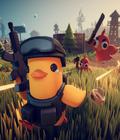After playing through the Gamescom demo of Pragmata last month, I was excited when Capcom invited me back to play the updated TGS demo. While the bulk of the demo content was the same, what Capcom prepared for TGS felt much more like a final game than the vertical slice that was prepared for Gamescom.
You play as Hugh, the last surviving member of a team sent to investigate the moon base known as the Cradle. A moonquake damaged the facility, so it's up to you and Diana, an android that looks like a young girl, to repair the damage and figure out where everyone went. Blocking your way is IDUS, the base AI, and plenty of aggressive robots.
New to this demo was a look at the Shelter. This is a section of the Cradle that serves as your home base in the game. It's a safe space that is free of enemies, allows you to upgrade abilities, upgrade weapons, and display collectibles.
The enhancement terminal uses upgrade components to enhance Hugh's suit or Diana's hacking abilities. This means you can increase Hugh's health or the length of time one of Diana's hacks stays active. It's essentially a way to level up Hugh and Diana as you adventure through the game and face increasingly tougher opponents. Upgrade components can be found throughout the game levels, but sometimes, you'll have to poke around for them. In the demo build, they weren't common, but they also weren't exceedingly rare.
Directly across from the enhancement terminal is the weapon upgrade terminal. This terminal allows you to use the Lunafilament you get from defeating enemies to upgrade weapons and hacking nodes, as well as unlock new abilities. For the demo, only two attachments were available to build: a repair cartridge (essentially a health pack) and thrusters (so you can jump farther).
Weapon upgrades include things like increasing the stagger effect and rate of fire on the Shockwave gun. There were only three weapon upgrade levels available. That may be applicable to the final game, but it may also be a limit specifically for this demo, as collecting enough Lunafilament to upgrade didn't seem like a particularly onerous task.
Another new element to this demo is the tram. In the Gamescom demo, the level I played appeared to be linear, with save points scattered throughout. It turns out those "save points" are actually tram connections. Instead of acting as simple save points, using one brings you back to the Shelter. You can also use any unlocked tram connection to return to that point in the level, but previously defeated opponents will be reset. This offers some risk/reward for players who are pushing ahead, as you can always go back to the Shelter to heal and upgrade, but the section you just cleared will need to be cleared again. On the other hand, it also means you don't have to worry about overlooking a needed upgrade component during a playthrough because you can always ride the tram back to a prior level and go hunting for missed items.
Hunting for items in creative places is something you'll want to do. Pragmata takes a cue from classic games with its Holowalls. If you see a wall that's a little bit sparkly for no reason, that's your indication to jump into it. I ran across one that contained a Read Earth Memory as well as some upgrade components. I expect similar caches to be hidden throughout the game, tempting both completionists and guide writers to find them all.
The Read Earth Memories (or REMs) are used to create replica items from Lunafilament. I found two in the demo stage, one of which was a globe that was out in the open. Giving the globe REM to Diana in the Shelter made her quite happy. She gave me a Cabin Coin as a thank you.
The Cabin Coin didn't have a direct use in the demo, and the Capcom PR reps didn't want to say what it was used for, so there's likely a story element that won't be revealed until the full game. However, trading REMs for coins seems like a pretty clear allusion to trading dreams (AKA REM sleep) for money. It has me wondering what the developers are cooking up on the narrative side. There was also a brief note buried in one of the terminals talking about 24/7 surveillance at the Cradle and how one worker's small mistake went viral because of it. Perhaps the Cradle isn't as great as it first appears....
As I'd mentioned earlier, the playable area of the game outside the Shelter was very similar to the playable level in the Gamescom demo, so I won't rehash the common details. There were some small changes to obstacles and puzzles, but the most noticeable update was to the game balance. Whereas the Gamescom demo was balanced for a new player with no experience, the TGS demo I played felt as though it was tuned for a retail experience.
Hugh started the game with less health, and enemies were more aggressive but not overwhelming. It felt like a default challenge level of "fun but fair" because it forces the player to actively use the hacking mechanic.
Diana's hacking ability is central to how Pragmata plays, and you won't get far if you try to ignore it. Trying to describe it inevitably sounds clunky (target an enemy with a hack, solve a minigame puzzle, and then shoot), but in practice, the mechanic is exceedingly smooth. Hacking never felt tacked on during combat, and that's important because there is plenty of shooting in Pragmata.
I was able to complete the Gamescom demo on a single run, but I had to return to the Shelter to upgrade Hugh and Diana's abilities for the TGS demo. It felt like a natural part of the gameplay loop, letting me turn loot into things I could use. Going back and forth to the Shelter also made me realize that Pragmata may ultimately be structured more like a Metroidvania than a level-based action game. Given that there were weapons and abilities revealed in the Pragmata Shelter Overview trailer that weren't available in the demo, it has me wondering if there are areas in the early levels that you can't access until you've acquired the relevant upgrades down the line.
Although it had a lot in common with the previous demo, Pragmata's TGS demo had enough new content to make it feel fresh and engaging. It was polished to a level that makes me suspect we'll see the final game released in the earlier months of 2026, but Capcom has yet to announce an official release date beyond "next year." I can't wait.
More articles about Pragmata











 Set in a dystopian near-future on Earth's Moon, Pragmata will take you on an unforgettable, adventure.
Set in a dystopian near-future on Earth's Moon, Pragmata will take you on an unforgettable, adventure.












































